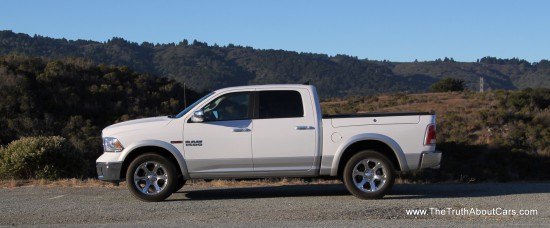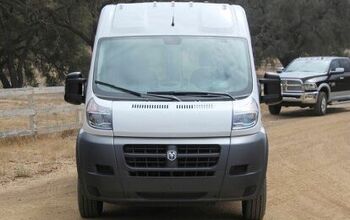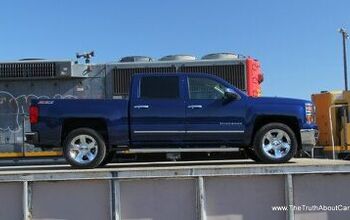Review: 2014 Ram 1500 Eco Diesel (With Video)

There’s just something about a diesel pickup truck that makes grown men regress into Tonka-loving children. Even my Prius-driving environmentalist friends in Berkeley admit they secretly want a diesel pickup. The problem of course is that diesel pickups are expensive (the cheapest diesel Ram 2500 is $36,975 and it doesn’t have an automatic transmission, the cheapest oil-burning F-250 is $38,250) and, for the majority of us, the high payload and towing capacities are overkill. While economical in a specific sense, the large diesel trucks aren’t “fuel-efficient” either. Until now. Mark your calendars folks, The 2014 Ram 1500 Eco Diesel is the half-ton truck in America sporting a small diesel engine.
Exterior
Although new in 2010 and refreshed for the 2013, the 1500 is undeniably a Ram. That’s because Chrysler prefers evolutionary rather than revolutionary styling when it comes to their volume truck. That’s not a bad thing, since the 1994 style cues that have lived on were sexy back then, and still attractive today. The big-rig front end still captures my attention, but despite my family’s Ram addiction, I find the 2014 Silverado’s nose to be the better looker. As with most redesigns, the front end got bigger, brasher and has more chrome than ever before.
As you’d expect from Chrysler’s best-selling vehicle, you can get your Ram in a bevy of configurations. There are 9 trim levels, three cabs and three bed sizes available. Mix and match them and you can drive for miles without seeing an identical Ram. Of course two of those 9 trim levels cannot be injected with some diesel love. Thankfully however the trims are excluded are the Sport and Express, meaning the base Tradesman trim is diesel eligible, bringing the diesel pickup entry point down to $28,465, $8,150 less than the cheapest diesel truck in 2013. Interestingly, nothing outside calls attention to the engine under the hood aside from the EcoDiesel badging on the front quarter panels. Out back, we get twin chrome exhaust tips, just like the V8 model and the engine idles so quietly most people assumed a gasoline V6 was under the hood. More on that later.
Interior
As I said in my Silverado review last week, I was surprised that GM didn’t delay the Silverado launch to spend some time polishing up the interior. Despite the re-tweaked 2013 Ram being on the market a year before GM’s truck launched (and the basis for that interior landing in 2010) the Ram still has the best interior in the segment. Your level of interior refinement varies by trim level with the entry-level Tradesman model using plenty of hard plastics while the top-end Ram coats in the interior in stitched leather and real wood trim. In an interesting move, SLT and Laramie models can be optioned to have the same two-ton dash as the top-end Long Horn edition although the real wood and a few other niceties are skipped. Regardless of the trim, controls are conveniently located and easy to operate. While certain models keep a traditional column shifter, most Ram 1500s will be equipped with Dodge and Ram’s Jaguar-like rotary-knob shifter. While I agree that it saves console space vs a console mounted unit, it strikes me as “gimmickier”. I found it tricky to use at first but did become used to it after a week.
Front seat comfort in the Ram is excellent, but a hair behind the Silverado. That’s thanks largely to someone at Chrysler’s ergonomics department that has a concave posterior. All of Chrysler’s latest seat designs have a pronounced (and firm) bottom cushion that feels like you’re sitting on an exercise ball. Although less of a problem in the Ram than in the Chrysler 200, the problem is still present. Despite this I had no issues driving the Ram for 2 hours at a time and I still found it a better place to spend my time than an F-150. Rear seats are lower to the floor than in Chevy’s new truck and slightly less comfortable as well.
Infotainment
Things start off with uConnect 3.0 which is a basic head unit with a 4-line monochromatic display. Similar to Ford’s basic SYNC system, uConnect 3.0 offers full MP3/iDevice integration for media without the fancy graphics. Next we have uConnect 5.0. While this middle tier system may look like the uConnect system we have seen before, it’s actually unrelated. Running on a Microsoft embedded OS and not QNX (a UNIX variant), the unit is more sluggish than the 8.4-inch system but offers many of the same features excluding navigation. While other Chrysler and Fiat models will have the option to add TomTom navigation later, that doesn’t appear to apply to the Ram.
Our Laramie model was equipped with the second generation uConnect 8.4 system. The second generation system adds smartphone app integration, emergency crash notification and 911 assist (along the lines of OnStar). The big deal here is the inclusion of a dedicated Sprint cellular modem integrated into the system. This allows the head unit to function similarly to OnStar in that you don’t have to have a paired Bluetooth cell phone to get emergency services (like you do with Ford’s MyFord Touch). uConnect can also act as a 3G WiFi hot spot if you pay for the right subscription. Software updates can be downloaded over the air and the user can buy/download apps via the integrated app store, just like a smartphone. The standard 6-speaker sound system is not much to write home about, but the seven or nine speaker Alipne system that comes standard with the 8.4-inch touchscreen on most models has a balanced and natural sound.
Base models still have a 305 horsepower 3.6L V6 borrowed from Chrysler’s passenger cars, good for 269 lb-ft of torque. That’s about the same as Ford’s 3.7L V6 but well below GM’s truck-only 4.3L engine. Shoppers can still get some HEMI-love by checking the box for the second generation 5.7L V8 making 395 ponies and a healthy 410 lb-ft of torque. But gasoline engines aren’t what’s new, it’s the diesel burning 3.0L V6 that we’re all here to talk about. But first we need to walk back in time.
In 2007 GM purchased 50% of the Italian engine maker VM Motori. The logic was that GM needed a smooth Euro compliant diesel engine for the Cadillac CTS (and other models) in order to compete with the Germans. Sadly, GM declared bankruptcy between the engine being designed and the engine actually being used so it sat on a shelf. In 2011 Fiat bought the other half of VM Motori and found the engine gathering dust. Fiat had some quick tweaks done to the engine to make it more suitable for their use and the EcoDiesel V6 was born. While there was much talk about GM getting their hands on this same engine for Silverado duty, Fiat recently snapped up the other half of VM Motri making this a Fiat/Chrysler engine in every way that matters.
The high revving single turbo aluminum-block V6 engine produces 240 horsepower and a stout 420 lb-ft of torque. If those numbers sound impressive, consider this. The first 5.9L Cummins engine Chrysler used in the 2500 and 3500 series RAM trucks produced 94 fewer ponies and 20 fewer twists. In the biggest statement of progress I have seen in a while, that Cummins also delivered its power via five fewer gears.
Like the rest of the Ram 1500 lineup (except for one model with a 5.7L HEMI), all 1/2 ton Rams now use ZF’s 8-speed automatic transmission. If you’re worried it’s just a passenger car transmission that’s not up to the task, ZF’s 8-speed transmissions are also found behind the insane twin-turbo V12s that the Germans love so much.
Towing & Payload
The 2014 Silverado’s 1,875 to 2,100 pound payload easily bests the Ram’s 1,340-1,620 pound range and even the F-150’s 1,510-2,090 is superior depending on how you align the trim level comparisons. (Ford still offers a “Heavy Duty” package on the F-150 which gives it a stronger frame comparable to the F-250 but Ram and GM have killed similar packages on their models.) Likewise the Ram Eco Diesel’s 9,200lb tow rating pales in comparison with the Silverado’s 12,000lb towing rating. Until you actually tow or haul that is.
Drive
Unless you need those extra pounds of payload capacity (a valid point to be sure), most shoppers will be better off with the Ram. Why? Because of how it tows and hauls. Let’s start with the 8-speed automatic. Even if you don’t choose the diesel engine, the 8-speed automatic’s greater ratio spread and faster gear changes more than bridge the 30-36 lb-ft divide between the Silverado and the Ram V6 and V8. That ratio spread and the high 4,800 RPM redline of the small diesel engine combine to make the Ram drive more like a gasoline V8 truck around town. With my 7,500lb trailer (loaded) attached, the 1500 Eco Diesel pulled effortlessly up steep grades with the transmission cranking out shifts like a Gatling gun. The small diesel and tall final gear allowed the 5,800lb pickup truck to average an impressive 24.2 MPG during my week with the truck which included out towing, hauling and 0-60 tests. On the open highway it had no trouble averaging 29 MPG at 70 MPH.
This is going to sound nuts to some, but I’m actually disappointed with the way the engine sounds. Chrysler fitted an ultra quiet exhaust system and more foam padding than a teenager’s bra to the 3.0L V6. This means that aside from a glow-plug icon on the dash that flashes for a millisecond, you’d be hard pressed to know a diesel is under the hood. After the engine has been started you get a brief moment of diesel clatter before it settles down to a quiet idle. When pressed, the engine clatters a hair more but it never sounds like a 3/4 ton diesel. Pity.
Ram raised eyebrows when they announced that their half ton truck would use coil rather than leaf springs in the rear suspension. The change has been lauded by some and vilified by the folks with Calvin-peeing-on-Ram stickers on their trucks. The truth is of course somewhere in the middle. Coil springs are more complicated to design because the spring doesn’t locate the rear axle, making trailing arms and other links necessary. Coils also handle overloading poorly when compared to a more traditional leaf setup. On the flip side, coils weigh less, provide a better ride, greater articulation and help in reducing wheel hop when the bed is empty. The simple truth is that the vast majority of pickup trucks spend their time with an empty bed. The spring rate chosen is an obvious trade off to deliver the RAM’s class leading road manners but it does result in payload capacity being about 400lbs lower than the Silverado at a maximum. Thankfully Chrysler’s 5-link suspension design, adapted from the previous generations of Grand Cherokee, maintains its poise when fully loaded (unlike GM’s 1960s attempt at coils.)
The bigger benefit of using a four-corner coil suspension is that it was relatively easy for Chrysler to adapt the Grand Cherokee’s height-adjustable air suspension system to the 1/2 ton truck. The $1,695 system is available on all quad cab and crew cab models, in all trims and in every driveline and engine configuration. In my opinion, the air suspension and $230 integrated trailer brake controller are worth every penny. Yes, the suspension allows you to vary the RAM’s ride height from 6.7 inches to 10.7 inches, but the real reason I’d pay money for it is that it also load levels. Keeping the suspension at the middle of its travel results in a better ride and more effective damping whether your truck is loaded or not.
The Eco Diesel is listed as a $4,000 option over the V6, but there are a few “hidden” costs. The only model that can’t get the 3.0L wonder is the short bed, short cab Tradesman meaning you’ll have to pay $385 for the 8-foot bed to be eligible. You’ll also have to pay $500 extra for the heavy-duty version of the 8-speed automatic bringing the total up to $28,465. That means the true premium is $4,885 at the Tradesman level. Versus the 5.7L HEMI, you’ll pay $3,350 more. When you run the numbers, the diesel won’t save you much over the 3.6L V6 but the V8 is a different matter. Even at the high fuel costs in California (and considering the cost of urea) the diesel would save nearly $750 a year in fuel resulting in a possible payback in under 5 years at 15,000 miles a year.
Even without the Eco Diesel, the Ram is the first choice in the half ton market unless you needed the maximum towing or payload capacities delivered by the 2014 Silverado. It doesn’t hurt that the Ram is slightly cheaper than the Ford or Chevy when comparably equipped. Toss in the first small diesel, the only 8-speed automatic, a load leveling air suspension system and you have quite simply the best tow vehicle in the half-ton segment. Considering that the Ram Eco Diesel is only $2,720 more than a V8 F-150 and $2,560 more than a V8 Silverado, your pay back window is even shorter than compared to Ram’s own HEMI. Or for folks like my dad who are looking to replace their 15 year old RAM 2500 Cummins but are suffering from modern 3/4 ton sticker shock, the 1500 diesel makes an interesting proposition. Compared to that generation of Ram 2500, this Ram 1500 is more capable in nearly every way. Thanks to GM needing a European market diesel Caddy and Chrysler’s bankruptcy and resurrection by Fiat, we have quite simply the most exciting vehicle I have driven this year.
Chrysler provided the vehicle, insurance and one tank of diesel for this review
Specifications as tested
0-30: 2.38 Seconds
0-60: 7.75 Seconds
1/4 Mile: 16.03 Seconds @ 84 MPH
Cabin noise at 50 MPH: 67 dB
Average Observed Fuel Economy: 24.2 MPG over 765 miles

More by Alex L. Dykes
Latest Car Reviews
Read moreLatest Product Reviews
Read moreRecent Comments
- SCE to AUX They're spending billions on this venture, so I hope so.Investing during a lull in the EV market seems like a smart move - "buy low, sell high" and all that.Key for Honda will be achieving high efficiency in its EVs, something not everybody can do.
- ChristianWimmer It might be overpriced for most, but probably not for the affluent city-dwellers who these are targeted at - we have tons of them in Munich where I live so I “get it”. I just think these look so terribly cheap and weird from a design POV.
- NotMyCircusNotMyMonkeys so many people here fellating musks fat sack, or hodling the baggies for TSLA. which are you?
- Kwik_Shift_Pro4X Canadians are able to win?
- Doc423 More over-priced, unreliable garbage from Mini Cooper/BMW.































































Comments
Join the conversation
Ram Eco Diesel : How is it possible this name actually passed the oxymoron filter at Chrysler without anyone saying anything?
this truck might have pushed ford to reveal a diesel option in the next few weeks. if they could get 420lbft out of the 3.2 5cyl duratorque motor reliably that would be a great option. I would buy that over this if the power was the same. this v6 is very powerful for its size and the 8 speed really makes it fast for what it is.